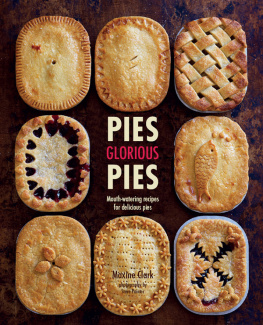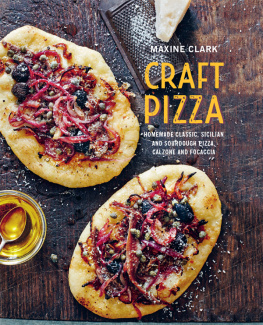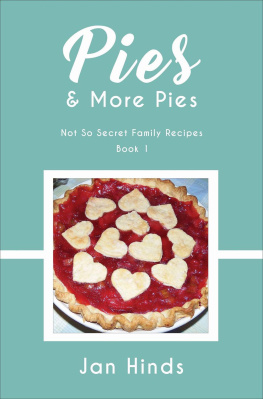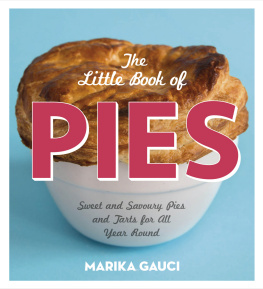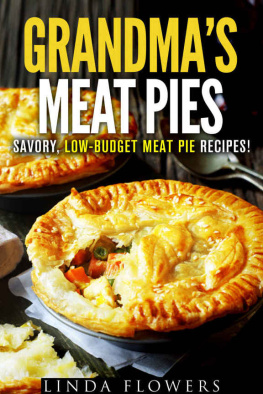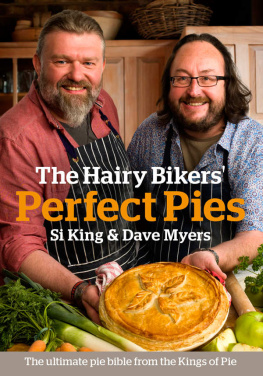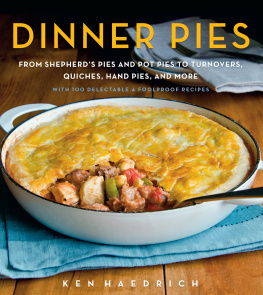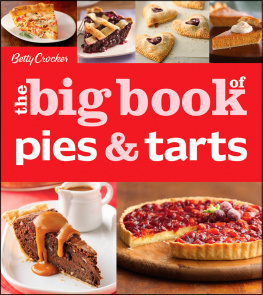PIES GLORIOUS PIES


PIES GLORIOUS PIES
Mouth-watering recipes for delicious pies
Maxine Clark
photography by Steve Pointer


Dedicated to the memory of Norman Lee (19272012), artist, raconteur, bon viveur and a man who loved a Scotch peh.

Maxine Clark is a leading food stylist, writer and a gifted cooking teacher. After she gained a Distinction from Leiths in London, she went on to teach there after graduating. She has also taught gourmet cookery holidays at Alistair Littles Tasting Place and Stirred Travel in Sicily, Tuscany and Veneto. Her work regularly appears in magazines and newspapers, particularly in Food and Travel and BBC Good Food. For Ryland Peters & Small she has also written Flavours of Tuscany, Risotto and Craft Pizza.
Steve Painter is a photographer, prop stylist, designer and art director in the seaside town of Hastings. For Ryland Peters & Small he has designed the number one bestselling Hummingbird Bakery and the award-winning How to Make Bread, which he also photographed. Other titles he has worked on include Vegetable Perfection, Sheet Pan Cooking and Piled High Potatoes.
DESIGN, PHOTOGRAPHY AND PROP STYLING Steve Painter
EDITOR Rebecca Woods
PRODUCTION MANAGER Cordana Simakovic
ART DIRECTOR Leslie Harrington
EDITORIAL DIRECTOR Julia Charles
IHDEXER Hilary Bird
FOOD STYUST Lucy McKelvie
FOOD STYUSTS ASSISTAHT Ellie Jarvis
First published in 2012
This revised edition published in 2020 by Ryland Peters & Small
2021 Jockeys Fields
London WC1R 4BW
and
341 E 116th St
New York, NY 10029
www.rylandpeters.com
10 9 8 7 6 5 4 3 2 1
Text Maxine Clark 2012, 2020
Design and photographs Ryland Peters & Small 2012, 2020
Printed in China
The authors moral rights have been asserted. All rights reserved. No part of this publication may be reproduced, stored in a retrieval system, or transmitted in any form or by any means, electronic, mechanical, photocopying, or otherwise, without the prior permission of the publisher.
ISBN: 978-1-78879-237-0
E-ISBN: 978-1-78879-310-0
A CIP record for this book is available from the British Library.
US Library of Congress CIP data has been applied for.
NOTES
All spoon measurements are level unless otherwise specified.
All vegetables are medium sized unless otherwise specified.
All eggs are medium (UK) or large (US), unless otherwise specified. It is recommended that free-range, organic eggs be used whenever possible.
Ovens should be preheated to the specified temperatures. All ovens work slightly differently. We recommend using an oven thermometer and suggest you consult the makers handbook for any special instructions, particularly if you are cooking in a fan-assisted/convection oven, as you will need to adjust temperatures according to the manufacturers instructions.
CONTENTS

INTRODUCTION
I simply cant remember life without a pie. Not that I was weaned on pies, but pies were, and still are, very much part of life here in Scotland where I was born and now live. Theres something truly comforting and comfortable about a pie a secret filling nestling inside a golden crust. Watch someone bite into a pie and they will inevitably make some sort of pleasing facial gesture and look at the pie they have just bitten into to examine its glorious contents!
Of course there are a million different pies out in the big wide world single-crust, double-crust, raised, cold, hot, small, large, with potato topping instead of pastry. Every country has their own variations of a pastry-enclosed filling, be it an Indian samosa, an Italian torta, a Spanish or Mexican empanada, a Scotch bridie, an English steak and kidney pie with mash and liquor, or an American pot or plate pie.
My first memories of pies were the little rhubarb pies sitting in ranks in the bakers window that I passed every day on my way home from school. The pastry was a hot-water crust and the filling quite tart, but they were dusted in a thick coating of sugar and I would buy one and munch it on the bus, showering sugar all over my uniform! Then there was my mums apple pie: single crust and baked in her grandmothers round enamel dish, with a crackling sugary crust on top. And my brother and sister and I just couldnt wait to have our Fray Bentos Steak and Kidney Pie we thought that a pie in a can was the height of chic!
Since then my tastes have broadened somewhat. Cornish holidays in the late 60s were a pie eye-opener, from Elizabeth Browns insanely deep and delicious apple pie, served in the restaurant of the St Mawes Hotel, to Doris Tiddys legendary pasties (see ). After tasting these, there was no going back. I realized the beauty and diversity of a well-made pastry crust and just how delicious a filling could be however simple the ingredients! Then at Leiths School of Food and Wine came the revelation of executing a hot-water crust and raising a pie well there was now no going back, and pies became an essential part of life.
Why? I think its really the pastry. I love it and love making it in all its diverse forms. I took a while to master it, but once it clicked a whole new world of possibilities opened up. So follow my hints and tips learned and gathered over years of pastry making and you simply wont go wrong. From Basic Shortcrust or Suet Crust, to French Rich Butter Pastry, they all have their purposes and functions. Some make a better top crust than others, some are meant to stand upright and encase a filling whereas others are designed to puff up and melt in the mouth. All these pastries are made by mixing flour with either only butter or a mix of butter and lard or olive oil or suet. Each has a different flavour and texture, depending on the fat and flour used or the pastry method followed, to perfectly complement the filling hidden inside.
You can bake almost anything in a pie from four and twenty blackbirds to unfortunate barber-shop customers. All will taste the better for a pastry crust. The secret with pies is not to make the filling too wet or it will ooze out of the pastry and make it go soggy before it has time to crisp up (and I have a good waterproofing technique using egg wash to prevent this). Take a look at Pie Practicalities (see ) before you start for tips on achieving perfect pies for every occasion.
The book is divided simply into four chapters: Everyday Pies, Posh Pies, Portable Pies and Sweet Pies. Some are very easy, others require a little more skill and patience, and other more complicated pies just require careful time-planning.

